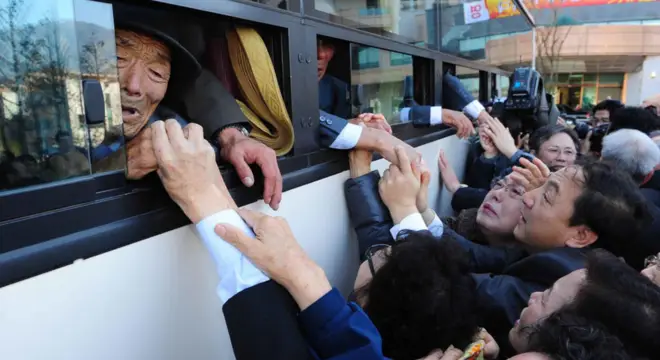Have you ever imagined being unable to see your own parents, siblings, or grandparents for decades?
Can you picture the pain of wondering whether your loved ones are alive, yet not being able to contact them?
What if political tensions stood in the way of a simple family reunion?
For thousands of Koreans, this is not just imagination — it’s reality. Families separated by the Korean War of 1950–53 have spent decades apart, unable to communicate, meet, or even send letters. With South Korean President Lee Jae Myung urging North Korea to resume family reunions, hope flickers once again. Let’s explore.
1. Historical Context: Families Torn Apart by War
Since the end of World War II, the Korean Peninsula has endured a separation that was exacerbated by the Korean War. Millions of families were separated, and the Korean War ended with an armistice, but not a peace treaty. The implication of this is that the two Koreas are still technically at war.
Since that time, over 134,000 South Koreans have applied to participate in family reunions, though as of 2025 only 35,311 survived, with many being over 80 years old. Family reunions have always been severely limited in duration and run by the state, including the limited but nevertheless occasional family reunions staged in South Korea around Chuseok, the Korean thanksgiving holiday, each year.
2. President Lee Jae Myung’s Humanitarian Appeal
On October 3, 2025, President Lee met with the aging South Korean population who had family members who were in the North, urging Pyongyang to consider previously discussing family reunions. He stated these family reunions “are important to humanity even if there are political and military challenges.”
Lee stated that political leaders of both Koreas have responsibilities to allow families to:
- Find out whether their loved ones are alive
- Correspond with them via letter
- And, ideally, see them in person again.
He made his remarks from the Ganghwa Peace Observatory, which looked upon North Korea — a symbolic place for advocating for peace and family reunions.
3. The Emotional Toll on Families
The last chance to see separated families is upon us, with many family members in their 70’s, 80’s, or 90’s. The stories of families like Bae Ki-yeol and Pyon Seung-sok highlight the painful pasts of older Koreans.
- Bae Ki-yeol, who fled North Korea at the tender age of 23, wishes only for reunification and the ability to go home.
- Pyon Seung-sok, who is 96 years old today, did see his sister and cousins in 2005, because he was granted U.S. citizenship. But then he lost contact with them again. He recalls writing letters until 2013 when the correspondence was also stopped. The long wait has brought emotional agony that lasts all these years.
President Lee agrees, and he is guilty with the politics that has kept them separated.
4. Past Family Reunions
Since 2000, the two Koreas have hosted 21 rounds of reunions successfully bringing together over 20,000 family members. Even though these exchanges take place in short periods they are highly significant and are typically coordinated around family occasions like Chuseok or other holidays that family members can share.
The most recent reunions were in August 2018 during the Moon Jae-in administration and since then relations have cooled and North Korea in February 2025 destroyed the site intended for the reunions revealing tensions between the two nations.
5. Current Political and Humanitarian Challenges
The prospect of reunions is complicated by politics. North Korea has refused talks with South Korea in recent years, defining the inter-Korean relationship as “two hostile states.”
Yet, President Lee’s administration has tried conciliatory measures:
- Removing propaganda loudspeakers along the border
- Advocating for humanitarian engagement at the UN
- Promising policies for separated families, including DNA testing to confirm kinship
Even so, without cooperation from North Korea, these reunions may remain out of reach for the elderly families, whose time is rapidly running out.

6. The Role of Civil Society and International Organizations
Organizations such as the Committee for One Ten Million Separated Families and the International Committee of the Red Cross have been calling for family reunions. They ask international organizations and embassies in North Korea to help support humanitarian measures.
The campaigns stress that family reunions are not just a political issue: they are about human dignity, about closure, about the basic human right to be reunited with family.
7. The Symbolism of Reunions
Family reunions are emotional and symbolic, representing:
- A rare channel for inter-Korean cooperation
- Hope for reconciliation and future peace
- Closure for families torn apart by history
Even brief meetings, letters, or simple confirmations of life can provide decades of emotional relief and healing.
8. Looking Ahead
President Lee Jae Myung has pledged to make family reunions a top priority, seeking dialogue and cooperation with North Korea. He hopes to bring forward the day families can reunite, even if progress is slow.
While the path is uncertain, these humanitarian initiatives remind the world that humanity can transcend political hostility.
Conclusion
The separation of Korean families is a painful legacy of war, yet the stories of hope, perseverance, and longing continue to inspire. From elderly parents waiting to meet their children, to organizations fighting for humanitarian engagement, these reunions symbolize more than mere meetings — they represent healing, peace, and human connection.
As President Lee urges North Korea to consider reunions, we are reminded of the emotional weight carried by decades of separation.
This story reminds us that the bond of humanity and family is the most precious — and one day, it will be possible to see every Korean family reunited again.


